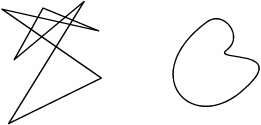Hack50.Give Big-Sounding Words to Big Concepts
|
Hack 50. Give Big-Sounding Words to Big Concepts
The sounds of words carry meaning too, as big words for big movements demonstrate. Steven Pinker, in his popular book on the nature of language, The Language Instinct1, encounters the frob-twiddle-tweak continuum as a way of talking about adjusting settings on computers or stereo equipment. The Jargon File, longtime glossary for hacker language, has the following under frobnicate (http://www.catb.org/~esr/jargon/html/F/frobnicate.html):
Why frob first? Frobbing is a coarse action, so it has to go with a big lump of a word. Twiddle is smaller, more delicate. And tweak, the finest adjustment of all, feels like a tiny word. It's as if the actual sound of the word, as it's spoken, carries meaning too. 4.8.1. In ActionThe two shapes in Figure 4-3 are a maluma and a takete. Take a look. Which is which?
Figure 4-3. One of these is a "maluma," the other a "takete"which is which? If you're like most people who have looked at shapes like these since the late 1920s, when Wolfgang Köhler devised the experiment, you said that the shape on the left is a "takete," and the one on the right is a "maluma." Just like "frob" and "tweak," in which the words relate to the movements, "takete" has a spiky character and "maluma" feels round. 4.8.2. How It WorksWords are multilayered in meaning, not just indices to some kind of meaning dictionary in our brains. Given the speed of speech, we need as many clues to meaning as we can get, to make understanding faster. Words that are just arbitrary noises would be wasteful. Clues to the meaning of speech can be packed into the intonation of a word, what other words are nearby, and the sound itself. Brains are association machines, and communication makes full use of that fact to impart meaning. In Figure 4-3, the more rounded shape is associated with big, full objects, objects that tend to have big resonant cavities, like drums, that make booming sounds if you hit them. Your mouth is big and hollow, resonant to say the word "maluma." It rolls around your mouth. On the other hand, a spiky shape is more like a snare drum or a crystal. It clatters and clicks. The corresponding sound is full of what are called plosives, sounds like t- and k- that involve popping air out. That's the association engine of the brain in action. The same goes for "frob" and "tweak." The movement your mouth and tongue go through to say "frob" is broad and coarse like the frobbing action it communicates. You put your tongue along the base of your mouth and make a large cavity to make a big sound. To say "tweak" doesn't just remind you of finely controlled movement, it really entails more finely controlled movement of the tongue and lips. Making the higher-pitched noise means making a smaller cavity in your mouth by pushing your tongue up, and the sound at the end is a delicate movement. Test this by saying "frob," "twiddle," and "tweak" first thing in the morning, when you're barely awake. Your muscle control isn't as good as it usually is when you're still half-asleep, so while you can say "frob" easily, saying "tweak" is pretty hard. It comes out more like "twur." If you're too impatient to wait until the morning, just imagine it is first thing in the morningas you stretch say the words to yourself with a yawn in your voice. The difference is clear; frobbing works while you're yawning, tweaking doesn't. Aside from denser meaning, these correlations between motor control (either moving your hands to control the stereo or saying the word) and the word itself may give some clues to what language was like before it was really language. Protolanguage, the system of communication before any kind of syntax or grammar, may have relied on these metaphors to impart meaning.3 For humans now, language includes a sophisticated learning system in which, as children, we figure out what words mean what, but there are still throwbacks to the earlier time: onomatopoeic words are ones that sound like what they mean, like "boom" or "moo." "Frob" and "tweak" may be similar to that, only drawing in bigness or roundness from the visual (for shapes) or motor (for mucking around with the stereo) parts of the brain. 4.8.3. In Real LifeGiven the relationship between the sound of a word, due to its component phonemes and its feel (some kind of shared subjective experience), sound symbolism is one of the techniques used in branding. Naming consultants take into account the maluma and takete aspect of word meaning, not just dictionary meaning, and come up with names for products and companies on demandfor a price, of course. One of the factors that influenced the naming of the BlackBerry wireless email device was the b- sound at the beginning. According to the namers, it connotes reliability.4 4.8.4. End Notes
4.8.5. See Also
|
|
EAN: N/A
Pages: 159
- Key #2: Improve Your Processes
- Beyond the Basics: The Five Laws of Lean Six Sigma
- Making Improvements That Last: An Illustrated Guide to DMAIC and the Lean Six Sigma Toolkit
- The Experience of Making Improvements: What Its Like to Work on Lean Six Sigma Projects
- Six Things Managers Must Do: How to Support Lean Six Sigma
